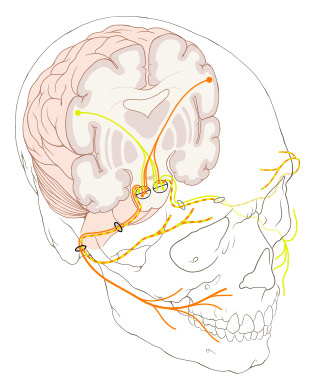
Anyone who has committed a crime should hope that the jury that tries him is happy. According to Forgas, his experiments show that cheerful people are easier to deceive, couldn’t detect lies as easily as those in negative moods and couldn’t tell a thief from an honest person. (…)
And there are more flip sides of happiness: Feeling good makes people more selfish (if asked to divide raffle tickets between themselves and others, they’ll keep more in their pockets than sad people) and worse at defending their opinions (they produce weaker, less detailed arguments). The happiest of us are also less creative than those who describe themselves as just “happy enough.”
Even just striving to feel cheerful might make us less happy.
{ Washington Post | Continue reading }
psychology |
April 11th, 2012

Physicist: Alright, the Earth has only one mechanism for releasing heat to space, and that’s via (infrared) radiation. We understand the phenomenon perfectly well, and can predict the surface temperature of the planet as a function of how much energy the human race produces. The upshot is that at a 2.3% growth rate (conveniently chosen to represent a 10× increase every century), we would reach boiling temperature in about 400 years. And this statement is independent of technology. Even if we don’t have a name for the energy source yet, as long as it obeys thermodynamics, we cook ourselves with perpetual energy increase. (…)
Economist: Consider virtualization. Imagine that in the future, we could all own virtual mansions and have our every need satisfied: all by stimulative neurological trickery. We would stil need nutrition, but the energy required to experience a high-energy lifestyle would be relatively minor. This is an example of enabling technology that obviates the need to engage in energy-intensive activities. Want to spend the weekend in Paris? You can do it without getting out of your chair.
Physicist: I see. But this is still a finite expenditure of energy per person. Not only does it take energy to feed the person (today at a rate of 10 kilocalories of energy input per kilocalorie eaten, no less), but the virtual environment probably also requires a supercomputer—by today’s standards—for every virtual voyager. The supercomputer at UCSD consumes something like 5 MW of power. Granted, we can expect improvement on this end, but today’s supercomputer eats 50,000 times as much as a person does, so there is a big gulf to cross.
{ Do the Math | Continue reading }
economics, ideas, technology |
April 11th, 2012

Scientists report that they have mapped the physical architecture of intelligence in the brain. Theirs is one of the largest and most comprehensive analyses so far of the brain structures vital to general intelligence and to specific aspects of intellectual functioning, such as verbal comprehension and working memory. (…)
“We found that general intelligence depends on a remarkably circumscribed neural system,” Barbey said. “Several brain regions, and the connections between them, were most important for general intelligence.”
These structures are located primarily within the left prefrontal cortex (behind the forehead), left temporal cortex (behind the ear) and left parietal cortex (at the top rear of the head) and in “white matter association tracts” that connect them.
The researchers also found that brain regions for planning, self-control and other aspects of executive function overlap to a significant extent with regions vital to general intelligence.
The study provides new evidence that intelligence relies not on one brain region or even the brain as a whole, Barbey said, but involves specific brain areas working together in a coordinated fashion.
{ University of Illinois | Continue reading }
brain, neurosciences |
April 10th, 2012

It’s a debate that’s been running since at least the days of Sigmund Freud: Can women climax from vaginal stimulation alone? And is there any difference between so-called clitoral and vaginal orgasms?
Now, a new series of essays lays out the evidence that vaginal and clitoral orgasms are, in fact, separate phenomena, activating different areas of the brain and perhaps revealing key psychological differences between women. (…)
Arguably, unraveling the mystery of whether vaginal orgasms exist should be simple: Ask women if they have them. But in practice, it’s a bit harder to tease out the exact sexual stimulation that leads to orgasm. French gynecologist Odile Buisson argues in her Journal of Sexual Medicine essay, for example, that the front wall of the vagina is inextricably linked with the internal parts of the clitoris; stimulating the vagina without activating the clitoris may be next to impossible.
Other research, however, would tend to suggest two distinct types of female orgasm. Barry Komisaruk of Rutgers University has conducted multiple studies in which women masturbate while having their brains scanned with a functional magnetic resonance imaging (fMRI) machine. The results show which sensory brain areas activate in response to stimulation. (…)
Most provocatively, some research links vaginal-only orgasms with both physical and mental health. The research is correlational, so it’s not entirely clear whether healthier women are prone to vaginal orgasms, whether vaginal orgasms somehow promote health, or whether some unknown factor links the two.
{ LiveScience | Continue reading }
science, sex-oriented |
April 10th, 2012

One of the great challenges in cosmology is understanding the nature of the universe’s so-called missing mass.
Astronomers have long known that galaxies are held together by gravity, a force that depends on the amount of mass a galaxy contains. Galaxies also spin, generating a force that tends to cause this mass to fly apart.
The galaxies astronomers can see are not being torn apart as they rotate, presumably because they are generating enough gravity to prevent this.
But that raises a conundrum. Astronomers can see how much visible mass there is in a galaxy and when they add it all up, there isn’t anywhere enough for the required amount of gravity. So something else must be generating this force.
One idea is that gravity is stronger on the galactic scale and so naturally provides the extra force to glue galaxies together.
Another is that the galaxies must be filled with matter that astronomers can’t see, the so-called dark matter.
{ The Physics arXiv Blog | Continue reading }
photo { Bela Borsodi }
mystery and paranormal, space |
April 10th, 2012

Robert Provine found that babies laugh 300 times a day, while adults laugh only 20 times. (…)
He’s actually proved that laughter is contagious. Consider the case of the “laugh epidemic” that swept through what’s now Tanzania in 1962. In the small town of Kashasha, three girls started giggling. Soon, the snickers rippled outward to 95 students, lasting for hours before dying down, then erupting again—for three months straight. The school closed down, briefly reopened, then shut down again after the laugh bug reinfected 57 students. Within ten days, laugh attacks plagued 217 kids in the nearby town of Nshamba, then 48 more in Bukoba. It continued to spread, closing 14 schools and afflicting about 1,000 people, before quarantines were put in place. A year and a half passed before this laughathon tailed off.
{ Mental Floss | Continue reading }
science |
April 10th, 2012
Internet users in Iran will be permanently denied access to the World Wide Web and cut off from popular social networking sites and email services, as the government has announced its plans to establish a national Intranet within five months.
{ IBT | Continue reading }
related { Why Iran Didn’t Admit Stuxnet Was an Attack }
asia, technology |
April 10th, 2012

One by one, pillars of classical logic have fallen by the wayside as science progressed in the 20th century, from Einstein’s realization that measurements of space and time were not absolute but observer-dependent, to quantum mechanics, which not only put fundamental limits on what we can empirically know but also demonstrated that elementary particles and the atoms they form are doing a million seemingly impossible things at once. (…)
Eighty-seven years ago, as far as we knew, the universe consisted of a single galaxy, our Milky Way, surrounded by an eternal, static, empty void. Now we know that there are more than 100 billion galaxies in the observable universe. (…)
Combining the ideas of general relativity and quantum mechanics, we can understand how it is possible that the entire universe, matter, radiation and even space itself could arise spontaneously out of nothing, without explicit divine intervention. (…)
Perhaps most remarkable of all, not only is it now plausible, in a scientific sense, that our universe came from nothing, if we ask what properties a universe created from nothing would have, it appears that these properties resemble precisely the universe we live in.
{ Lawrence M. Krauss/LA Times | Continue reading }
artwork { Ellsworth Kelly, White curve I (black curve I), 1973 }
ideas, science, space |
April 9th, 2012

A series of hacks perpetrated against so-called “smart meter” installations over the past several years may have cost a single U.S. electric utility hundreds of millions of dollars annually, the FBI said in a cyber intelligence bulletin obtained by KrebsOnSecurity. The law enforcement agency said this is the first known report of criminals compromising the hi-tech meters, and that it expects this type of fraud to spread across the country as more utilities deploy smart grid technology.
Smart meters are intended to improve efficiency, reliability, and allow the electric utility to charge different rates for electricity at different times of day. Smart grid technology also holds the promise of improving a utility’s ability to remotely read meters to determine electric usage.
{ KrebsOnSecurity | Continue reading }
scams and heists, technology |
April 9th, 2012

The study, reported in The Journal of Neuroscience [2007], provides the first direct evidence that humans, like rats, moths and butterflies, secrete a scent that affects the physiology of the opposite sex. (…)
He found that the chemical androstadienone — a compound found in male sweat and an additive in perfumes and colognes — changed mood, sexual arousal, physiological arousal and brain activation in women.
Yet, contrary to perfume company advertisements, there is no hard evidence that humans respond to the smell of androstadienone or any other chemical in a subliminal or instinctual way similar to the way many mammals and even insects respond to pheromones, Wyart said. Though some humans exhibit a small patch inside their nose resembling the vomeronasal organ in rats that detects pheromones, it appears to be vestigial, with no nerve connection to the brain.
“Many people argue that human pheromones don’t exist, because humans don’t exhibit stereotyped behavior. Nonetheless, this male chemical signal, androstadienone, does cause hormonal as well as physiological and psychological changes in women.” (…)
Sweat has been the main focus of research on human pheromones, and in fact, male underarm sweat has been shown to improve women’s moods and affect their secretion of luteinizing hormone, which is normally involved in stimulating ovulation.
Other studies have shown that when female sweat is applied to the upper lip of other women, these women respond by shifting their menstrual cycles toward synchrony with the cycle of the woman from whom the sweat was obtained.
{ ScienceDaily | Continue reading }
archives, hormones, olfaction, relationships |
April 9th, 2012

A general continuum theory for the distribution of hairs in a bundle is developed, treating individual fibers as elastic filaments with random intrinsic curvatures. Applying this formalism to the iconic problem of the ponytail, the combined effects of bending elasticity, gravity, and orientational disorder are recast as a differential equation for the envelope of the bundle, in which the compressibility enters through an ‘equation of state’. From this, we identify the balance of forces in various regions of the ponytail, extract a remarkably simple equation of state from laboratory measurements of human ponytails, and relate the pressure to the measured random curvatures of individual hairs.
{ arXiv | Continue reading }
painting { Botticelli, Portrait of Simonetta Vespucci, c.1476 }
hair, science |
April 9th, 2012

How to actually be good at rote memorization. A group of psychologists decided to help the kids out by examining the optimal duration for studying a particular item. (…)
Subjects who avoided the longest (16s) and shortest (1s) durations retained more information when testeed after 5 minutes and when tested after 2 days. (…)
Performance was much better for intermediate (e.g., 4 s) presentation durations.
I bring up this study not because it’s crucial for our education system, but because in the future every part of our lives will be designed based on this type of research. Advertisements, online dating profiles, and all manner of printed instructions will be optimized for the perfect exposure length.
{ peer-reviewed by my neurons | Continue reading }
memory, psychology |
April 9th, 2012

Red seems to affect us in a way that other colors don’t. (…)
Johns and colleagues test an hypothesis for why red on women looks so attractive to me. The hypothesis is that red is sexy because it reminds men of… lady parts. (…) One version of the hypothesis is that as females are approaching ovulation, the vulva becomes more red than is is at other points in the cycle.
If this “red is code for female sex organs” hypothesis is true, you might predict that men would judge female genitals as more attractive as they became more red.
Explicit images of anatomically normal, un-retouched, nonpornographic, similarly-orientated female genitals were surprisingly difficult to obtain… We selected photographs that … did not contain other, potentially distracting, objects (fingers, sex toys, piercings etc.) and were hairless to account for current fashion.
They showed their pictures to 40 males. Most of the men were in their 20s. (…) They rated the attractiveness of each image.
The ratings of attractiveness were the exact opposite of those predicted by the signalling hypothesis. The reddest images were rated the least attractive.
The authors are then tasked to come up with an hypothesis as to why redness is less attractive. Their suggestion is that red is suggestive of menstrual blood.
{ NeuroDojo | Continue reading }
colors, psychology, relationships, sex-oriented |
April 9th, 2012

The researchers in charge of performing psychometric testing recently made an interesting observation: if they wear a white coat when interacting with the participants (and their parents), they receive more respect.
According to a study by Hajo Adam and Adam Galinsky of Norwestern University, it’s possible that our psych testers not only look more professional, but subconsciously feel more professional. In other words, the clothes may literally make the man (or woman).
{ Gaines, on brains | Continue reading }
images { 1 | 2 }
psychology, relationships |
April 9th, 2012

{ Shoppers scan barcodes of products which are displayed at the Homeplus store located in a Seoul subway station. “You place an order when you go to work in the morning and can see the items delivered at home when you come home at night.” | photos + video | More: Tesco opens world’s first virtual store }
economics, technology |
April 9th, 2012
visual design |
April 8th, 2012

{ We show that if a car stops at a stop sign, an observer, e.g., a police officer, located at a certain distance perpendicular to the car trajectory, must have an illusion that the car does not stop, if the following three conditions are satisfied: (1) the observer measures not the linear but angular speed of the car; (2) the car decelerates and subsequently accelerates relatively fast; and (3) there is a short-time obstruction of the observer’s view of the car by an external object, e.g., another car, at the moment when both cars are near the stop sign. | Dmitri Krioukov/arXiv | PDF }
mathematics, motorpsycho |
April 8th, 2012

Whereas Android generates $1.70/device/year and thus an Android device with a two year life generates about $3.5 to Google over its life, Apple obtained $576.3 for each iOS device it sold in 2011.
{ ASYMCO | Continue reading }
related { iPhone Outselling All Other Smartphones Combined at Sprint and AT&T. }
economics, google, technology |
April 8th, 2012

{ When the authorities send a subpoena to Facebook for your account information, what do they receive? }
related:
This paper reports a study which investigated adult social activity on Facebook. The data was drawn from an online survey (N = 758) and 18 in-depth research sessions (semistructured interviews and verbal protocols). The research explored the function of Facebook in making contact, maintaining contact and facilitating extended contact with online friends and the concept of ‘facestalking’. It also examined how the specific tools of Facebook (wall postings, status updates, events and photos) are used to communicate and socialise. The research concludes that Facebook strengthens existing friendships by supplementing traditional forms of communication (face to face, telephone). Also, participation in the Facebook community enables efficient and convenient contact to be maintained with a larger and more diverse group of acquaintances, thus extending potential social capital.
{ IJETS | Continue reading }
A Wall Street Journal examination of 100 of the most popular Facebook apps found that some seek the email addresses, current location and sexual preference, among other details, not only of app users but also of their Facebook friends. One Yahoo service powered by Facebook requests access to a person’s religious and political leanings as a condition for using it. The popular Skype service for making online phone calls seeks the Facebook photos and birthdays of its users and their friends. (…)
Facebook requires apps to ask permission before accessing a user’s personal details. However, a user’s friends aren’t notified if information about them is used by a friend’s app. An examination of the apps’ activities also suggests that Facebook occasionally isn’t enforcing its own rules on data privacy.
{ WSJ | Continue reading }
law, relationships, social networks |
April 8th, 2012

Just five companies, Apple, Microsoft, Cisco, Google, and Pfizer, now hold nearly one-quarter of all corporate cash, equal to more than a quarter-trillion dollars. (…)
Netflix is now responsible for about one-third of all Internet bandwidth. (…)
As the economy tanked in 2009, the top 25 hedge fund managers collectively earned $25.3 billion. On average, that works out to about $2,000 a minute for each manager. (…)
A 2008 Swedish study found that unemployed people gradually lose the ability to read. (…)
The combined assets of Wal-Mart’s Walton family is equal to that of the bottom 150 million Americans.
{ Motley Fool | Continue reading }
related { 42% of households worldwide will have Wi-Fi by 2016; 25% today }
economics, technology |
April 8th, 2012






















